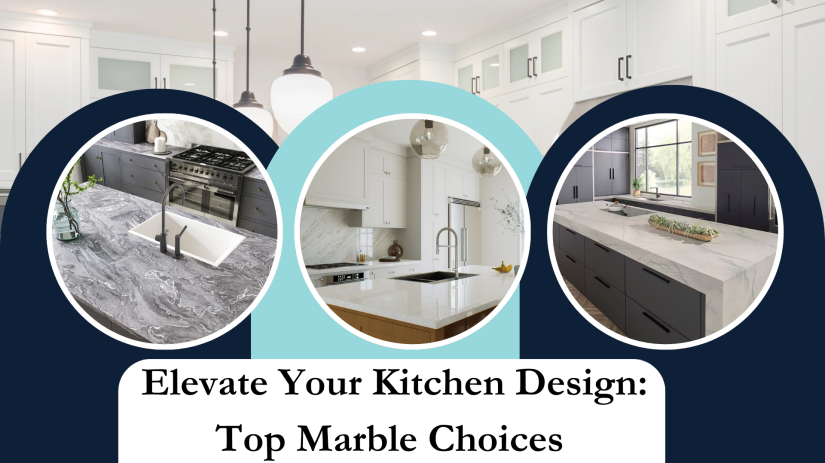The kitchen is often regarded as the heart of the home, where culinary creativity flourishes and families gather. A beautifully designed kitchen not only enhances your cooking experience but also adds significant value to your home. One of the most luxurious materials to consider for your kitchen surfaces is marble. With its timeless appeal and unique veining patterns, marble can transform your kitchen into a sophisticated and inviting space. In this guide, we will explore the best marble for the kitchen, considering both aesthetics and functionality.
1. Understanding Marble: A Brief Overview
Before diving into the best options, it’s essential to understand what makes marble a favored choice for kitchen design. Marble is a natural stone, formed from metamorphosed limestone. Its unique veining and color variations are due to the minerals present during its formation. Marble is prized for its beauty and elegance, making it a popular choice for countertops, backsplashes, and flooring.
2. Top Marble Options for Kitchen Design

When choosing the best marble for your kitchen, consider the following options based on aesthetics, durability, and maintenance requirements.
A. Carrara Marble
Characteristics: Carrara marble, originating from Italy, is renowned for its classic white background with soft grey veining.
Why It’s Great: It offers a timeless look that complements various kitchen styles, from traditional to modern. Carrara is relatively durable and works well for countertops and backsplashes.
Considerations: While beautiful, Carrara marble is porous and can stain if not sealed properly. Regular maintenance is necessary to keep it looking pristine.
B. Calacatta Marble
Characteristics: Calacatta marble features a white base with bold, dramatic veining, often in gold or grey hues.
Why It’s Great: Its striking appearance makes it a showstopper in any kitchen. Calacatta is ideal for kitchen islands and countertops, providing a luxurious touch.
Considerations: Like Carrara, Calacatta is also porous and requires sealing to prevent staining. It may be slightly more expensive due to its rarity.
C. Statuario Marble
Characteristics: Statuario marble combines the elegance of Carrara and Calacatta, featuring a white background with a mix of fine grey and golden veining.
Why It’s Great: Its versatility makes it suitable for a range of kitchen designs, and it stands out as a premium choice. Statuario is ideal for both countertops and wall accents.
Considerations: Statuario is also a porous stone, so maintenance is crucial to avoid damage and staining.
D. Nero Marquina Marble
Characteristics: Nero Marquina is a striking black marble with prominent white veining, offering a bold contrast.
Why It’s Great: This marble adds depth and sophistication, making it perfect for modern and contemporary kitchens. It works well for countertops, backsplashes, and even flooring.
Considerations: Nero Marquina is less prone to showing stains due to its dark color, but it still requires regular sealing and care.
E. Emperador Marble
Characteristics: Emperador marble comes in various shades of brown, with unique veining patterns that can range from light to dark.
Why It’s Great: Its warm tones create an inviting atmosphere, making it suitable for traditional kitchens. Emperador marble is durable and can withstand daily use.
Considerations: While it is less porous than lighter marbles, proper sealing is still recommended for long-lasting beauty.
3. Tips for Incorporating Marble in Your Kitchen Design
When designing your kitchen with marble, consider the following tips to ensure you achieve a cohesive and functional space:
A. Balance and Contrast
If you opt for a bold marble like Calacatta or Nero Marquina, balance it with lighter cabinetry or wall colors. This contrast will allow the marble to stand out without overwhelming the space.
B. Choose the Right Finish
The finish of your marble can significantly impact its appearance and functionality. A polished finish enhances the stone’s natural beauty but can be more susceptible to scratches. A honed finish offers a more matte appearance and is less slippery, making it ideal for countertops.
C. Consider Maintenance
Marble requires regular maintenance to keep it looking its best. Use pH-balanced cleaners and seal your marble surfaces regularly to protect against stains and etching.
D. Integrate with Other Materials
Pairing marble with other materials, such as wood or stainless steel, can create a dynamic and modern kitchen. Consider using marble for your countertops while incorporating wood for cabinetry and shelving.
E. Use Marble Accents
If you’re hesitant about using marble extensively, consider adding it as an accent. Marble backsplashes, cutting boards, or decorative elements can introduce this luxurious material without overwhelming your kitchen design.
Conclusion
Choosing the best marble for your kitchen can elevate your culinary space while adding lasting value to your home. Whether you opt for the classic elegance of Carrara, the bold statement of Nero Marquina, or the luxurious feel of Calacatta, each marble type offers unique characteristics that can transform your kitchen. By carefully considering your design preferences and maintenance needs, you can create a kitchen that is not only beautiful but also functional for everyday use.
FAQs
Q1: Is marble a practical choice for kitchen countertops?
A1: Yes, marble is a beautiful and luxurious option for kitchen countertops, but it requires regular maintenance to prevent staining and scratching.
Q2: How often should I seal my marble countertops?
A2: It’s recommended to seal marble countertops every 6 to 12 months, depending on usage and exposure to moisture.
Q3: Can I use dark marble in a small kitchen?
A3: Yes, dark marble can add sophistication to small kitchens, but balance it with lighter colors in cabinetry and walls to avoid a cramped feeling.
Q4: What type of finish is best for marble countertops?
A4: A honed finish is recommended for its matte appearance and reduced slipperiness, while a polished finish enhances the stone’s natural beauty.
Q5: Are there any specific care tips for marble in kitchens?
A5: Use pH-balanced cleaners, avoid acidic substances, and clean spills immediately to prevent staining and damage to your marble surfaces.

